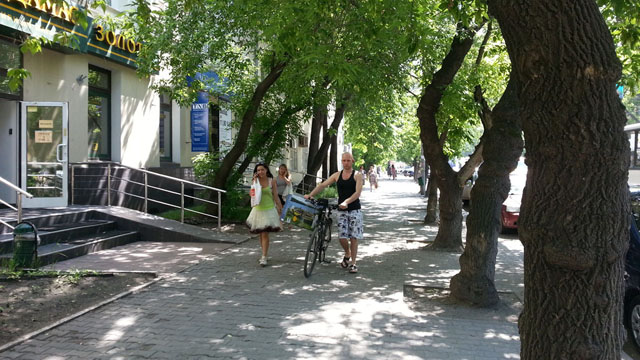
In Yekaterinburg (as well as in other Russian cities) town planners have have forgotten how to build urban streets. It’s a pity, given that the public space of the city mainly consists of streets and it’s the streets that most of us urban dwellers have to deal with everyday. If we don’t get the streets right we will have little chance of building a truly livable city.
First of all it is necessary to define the street. For the purposes of this text I propose the following definition. A street is a multifunctional linear public space formed by buildings’ frontages. That definition itself holds the problems that we’re going to discuss.
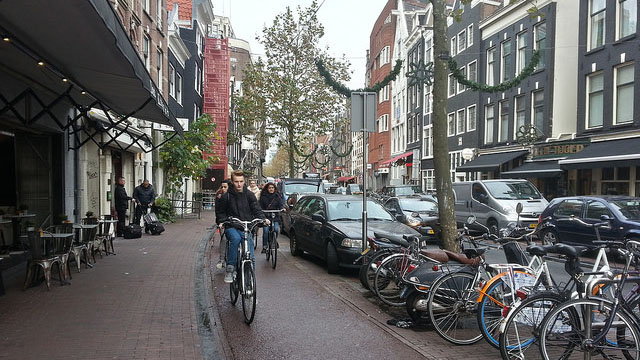
Street in Amsterdam
Roads instead of streets
The first problem, of course, it’s multifuntionality. Streets are primarily places of movement for people and vehicles. But at the same time they are much more than that. People can meet, sit, shop and window-shop etc. Cars here not only move but park. Drivers unload their cargo. Streets are places of gathering and entertainment. Figuratively speaking, streets are stages where each day a unique ballet of planned and spontaneous interactions is performed by numerous people.
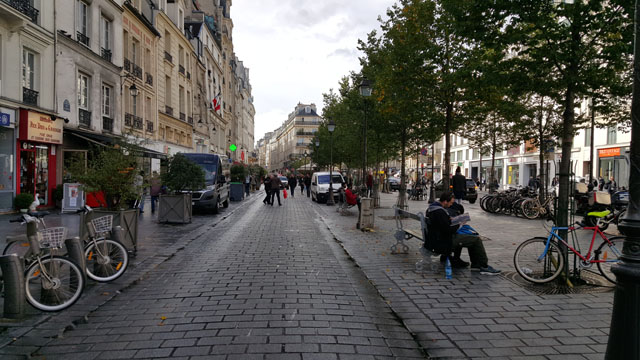
Street in Paris
Understading multifunctionality and complexity of streets is diffucult for those who design them, i.e. for transportation engineers. They understand the streets solely as infrastructure for movement. Their education background and the national road design standards reinforce those views. The ongoing work to reform the national standards is unlikely to change things for the better, at least as can be seen at this moment.
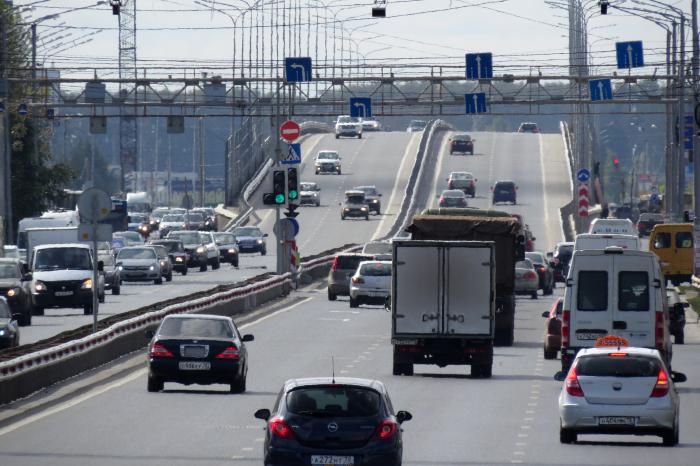
New street, anywhere in Russia
For example the new edition of the national standards for streets will likely prohibit installation of on-street parking on arterial streets. Why? Because on-street parking on those streets would presumedly be a nuisance and danger for moving vehicles because of all the cars pulling in our out of parking places. I say ‘presumedly’ because I’ve yet to come across a study that would objectify those claims based on empirical data.
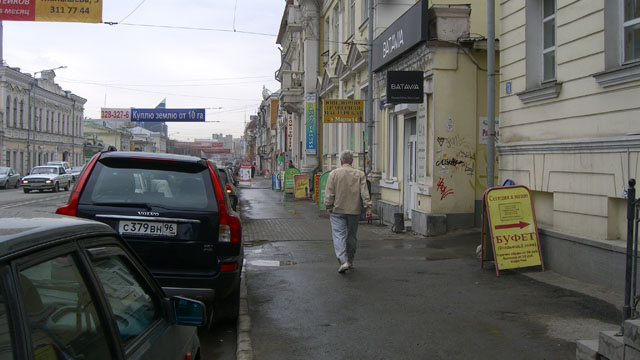
8 Marta street. Parallel parking protects the sidewalk
The transportation experts behind those standards, however well-intentioned they might be, don’t take into account that arterial streets are actually main streets of towns and cities where shops, cafes and all sorts of other businesses are located that need parking at least for deliveries, not to mention the customers. Moreover, on-street parking, i.e. a buffer of heavy metal boxes, on thoroughfares with lots of traffic is the only real way to create a minimal level of comfort for pedestrians.
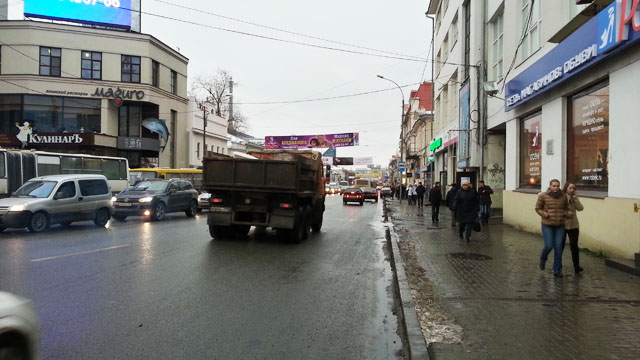
8 Marta street. After parallel parking was prohibited
Interestingly, function-based hierarchy of roads is not a Russian or Soviet invention. It was borrowed and adopted from international town-planning practice of the day. The international practice however is a moving target. For example in the most car-oriented country, the United States, the Institute of Traffic Engineers (ITE) after long battles with new urbanists came up with a new manual of context-sensitive solutions for designing walkable urban thoroughfares. In short, according to this manual, transportation planners should take into account not only the amount of traffic on the street but also the buildings and uses that exist or projected around them.
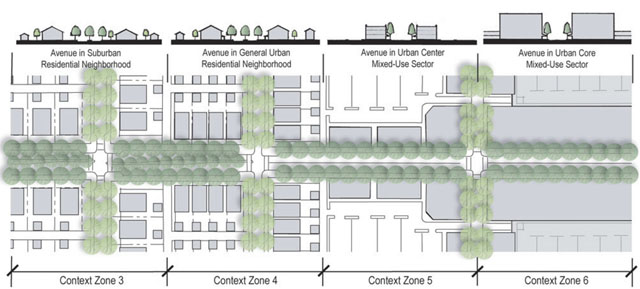
Context-based street design. Street desing should correspond to development around it
Inability to design streets in accordance with their context can sometimes be seen by the naked eye. Take for instance Krasnolesja street in Academichesky neighborhood. Everything in this street is designed as if it was a rural highway – the lane width, the highway median barriers, lack of trees, restriction of parking.
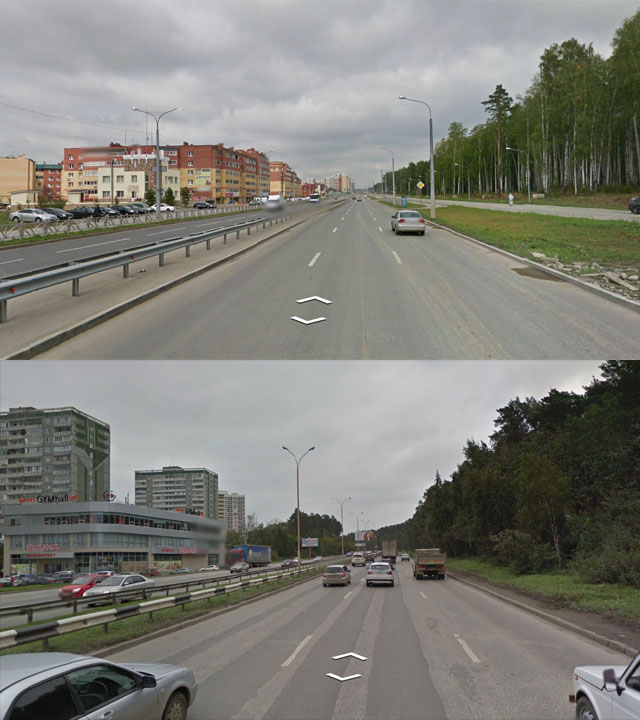
Krasnolesja street (above) and Yekaterinburg inner ring-road (below). Try to spot a few differences
Meanwhile this street runs through a residential neighborhood. There are lots of people walking and cycling, lots of businesses on the ground-floors and lots of windows overlooking this street. This disparity sometimes causes rather ugly remedial solutions like soundwalls.
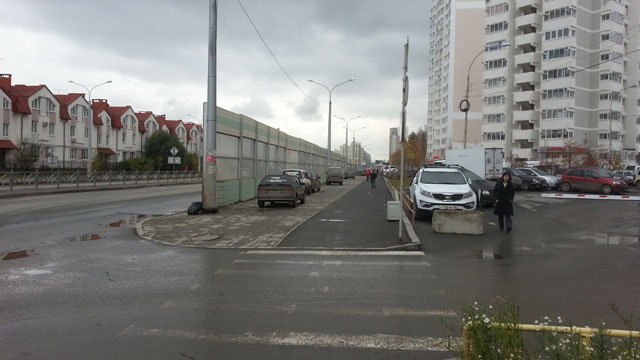
Soundwalls on Krasnolesja street
It is evident that the designers failed to create an adequate street for this place. That’s because they were not really designing a street – a multifunctional public space, but a road – a single-purpose linear infrastructure for traffic movement.
Issues of contemporary development
Inadequate design of horizontal infrastructure, i.e. building roads instead of streets, is one part of the problem. And it’s not the worst. The more substantial part lies in the development patterns that we have today.
Let’s take a look at the definition again. A street is a multifunctional linear public space formed by buildings’ frontages. For some space to become a street it should have vertical borders. A street is shaped by buildings like a coridor is shaped by walls.
Unfortunately, contemporary developemt for the most part does not serve that purpose. Moreover, the tasks that architects and developers are trying to solve in their projects often directly hinder the creation of attractive urban spaces.
Historically, buildings were constructed along a build-to line parellel to the street. That line was de facto and de jure a border between public and private space.
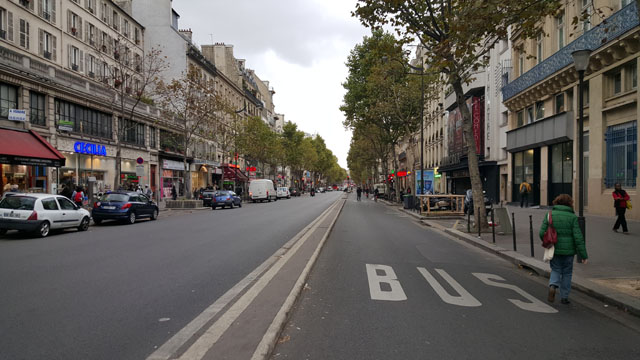
Parisian boulevard. Public space has clear vertical borders
On main thoroughfares ground-floors were ususally occupied by commercial functions that need heavy pedestrian traffic, i.e. shops, cafes etc.
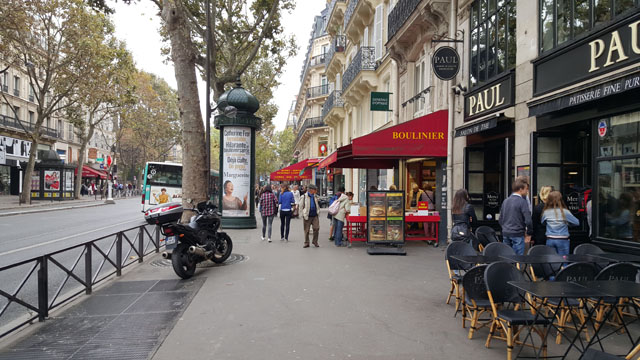
Sidewalk of a Parisian boulevard
On sidestreets groundfloors could be occupied by less-visited offices or even residences.
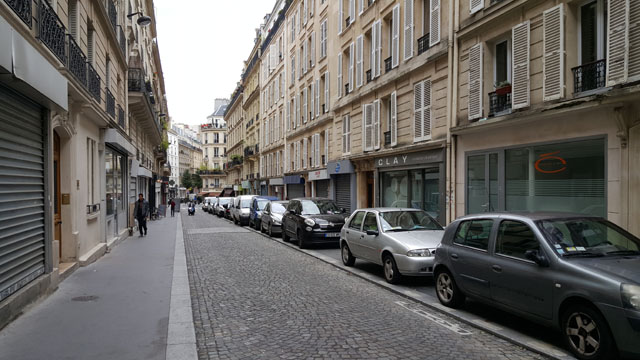
Sidestreet in Paris
In some cases buildings could have a small setback occupied for example by a front garden.
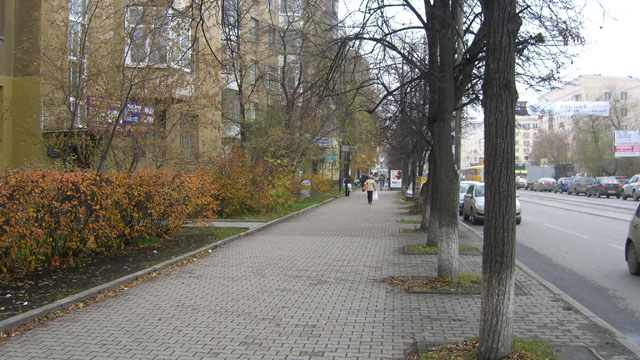
Sidewalk on Lunacharskogo street. Setback between the building and the sidewalk is occupied by greenery
Thus streets were constructed until mid-20th century. The last streets to be designed in that way in Yekaterinburg were built in the 1950s.
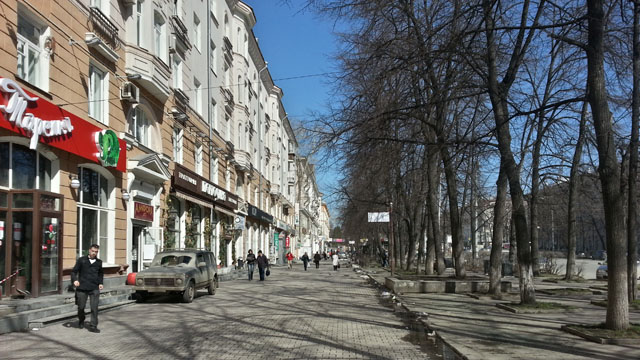
Lenina street towards UPI
Beginning in the 1960s, with adoptation of modernistic city planning principles, the discipline of street frontage along the build-to line was dissipated and forgotten. Freestanding builings became the fashion of the day.
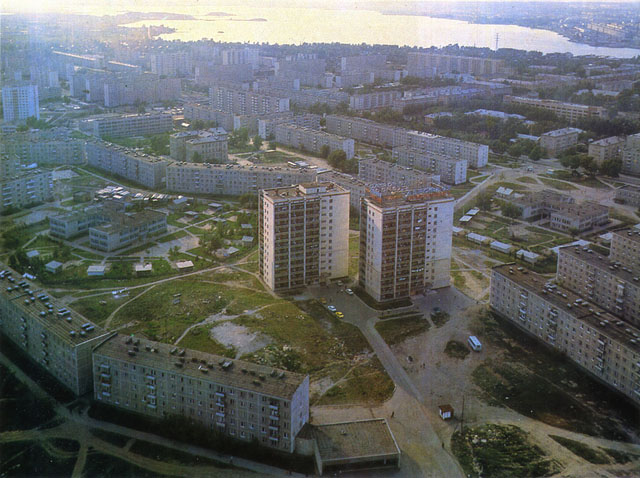
Verkh-Isetsky neighborhood. A superblock without a single street on the spot 9 blocks of the former factory village
At first it seemed like a good idea. In those new neighborhoods high-rise apartment blocks were standing amid wide green spaces. Compared to the dirty narrow streets of the past this seemed like a huge improvement especially since the real-estate quality was much better in new houses by comparison with the old ones.
At some point in time though it became clear that the planners threw the baby out with the bathwater. Wide streets in new neighborhoods turned out to be dysfunctional as public spaces. They were not really streets, but rather roads with building sparsely spread around them. These wide open spaces were too shapeless, too huge and too monotonous to be attractive for people to be in.
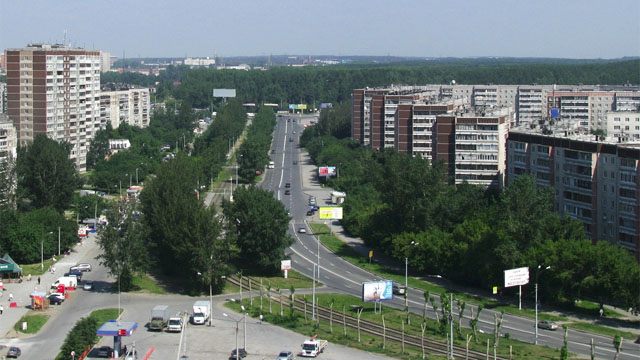
Syromolotova street
In regards to the yards – in these new areas they were too big to be cared for and gradually they became neglected or were occupied by uses such as individual garages or simply parking. The residents were unhappy with strangers crossing and hanging around in their yards, and so wide permeable green Soviet neighborhoods became a patch-work of fenced parcels.
In the end, city planners in Russia returned to the same idea that they’ve averted from in the 1960s – perimeter blocks. Developers now promote compfortable car-free yards as a benefit. Groundfloors are usually occupied with commercial uses. It seems that everything got back to normal.
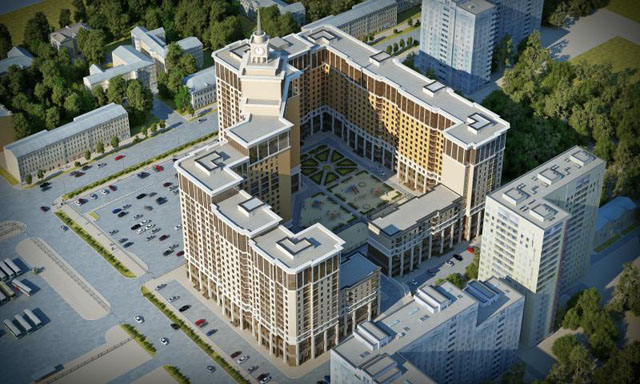
Residential complex on the intersection of Shorsa and Stepana Razina streets. A courtyard for residents, commercial uses on the groundfloor, but what happened to the streets?
The planners have returned traditional courtyards to residents but they’ve forgotten to return traditional streets, and urban lifestyle without streets is impossible. A courtyard can be as nice as it can be, but only little children spend all their time within the limits of the courtyard. All the others leave the courtyard and spend at least some time in the public space of the city. And sometimes this public space is so unattractive that people would prefer driving to their destinations, even if it is not rational to do that – only to avoid walking the streets.
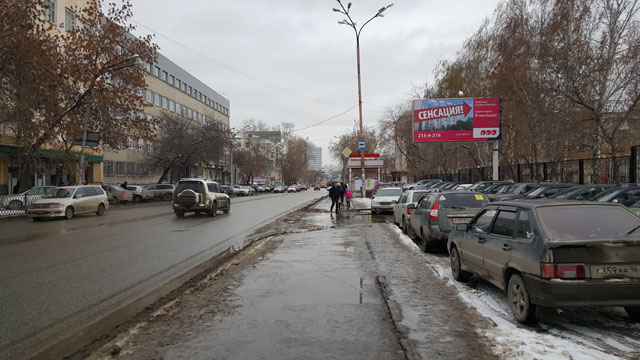
Sidewalk on Kuibysheva street
In a city with good streets walking is a pleasurable experience. Regardless of the weather streets are always interesting and diverse. In essence, quality public spaces (the biggest chunk of which are streets) is what makes city-living attractive. It is what a person gets in compensation for all the disadvantages of city-living (constrained space, inconvenience of driving, lack of private yard). If that compensation is not provided, then city-living is inferior to living in a suburb.
Buildings that don’t shape the streets
So what are the problems with modern buildings? As I’ve written above, construction along the build-to line was forgotten in mid-20th century. Today a building can face the street with almost anything. For example a corner of two streets in the center of the city can easily be formed with an entrance to a parking garage.
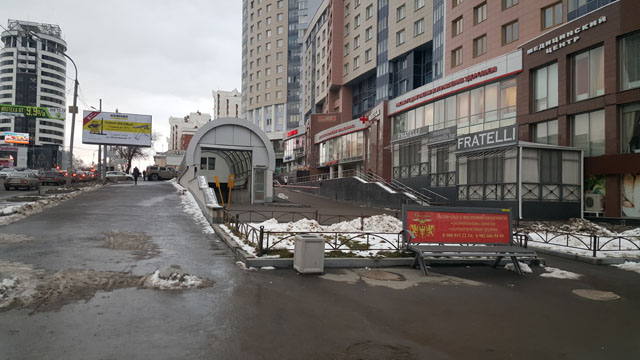
Intersection of Kuibysheva and Sheynkmana streets
Let’s just compare it with another street corner in 15-minute walk from the first one.
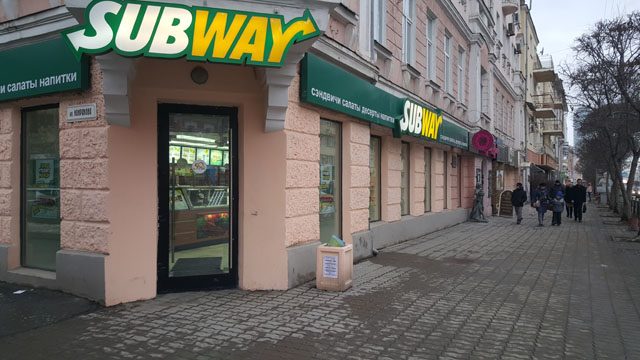
Corner of Malysheva and Hokhryakova streets
So called ‘guest parking lots’ are the main culprits behind the continuing degradation of our streets. The principle here is that a building is placed on a site with a big setback in which a parking lot is inserted.
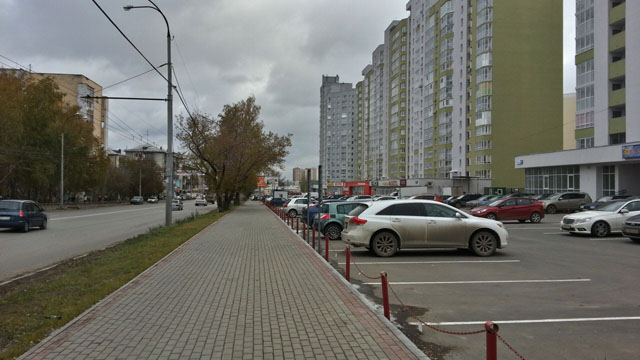
Shorsa street
People walking on the street end up between moving cars on the driveway and parked cars in the parking lot.
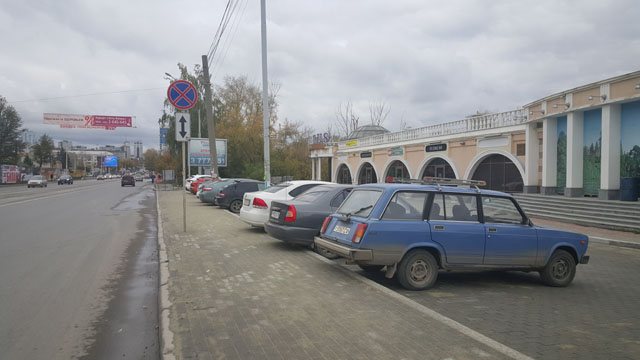
Kuibysheva street
Who would want to walk here?
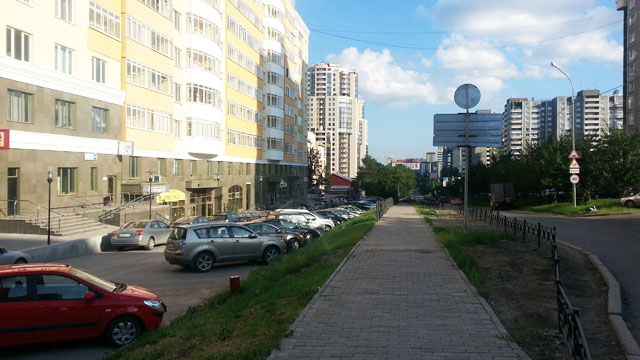
Sheynkmana street
The architects and developers are not the only ones to blame for this type of parking solutuon. For example ‘Summit’ business center on 8 Marta street sits on the build-to line, but this line itself it set so far back from the street sidewalk that in between a parking lot could be placed.

8 Marta street near ‘Summit’ business center. Sidewalk is separated from the building by a parking lot
What were the city planners thinking when they created a master plan for this place is a mystery. This site is right in the center of the city, served by all kinds of public transport including the subway, and this area in general hosts a great variety of uses that generate lots of pedestrian traffic. Quality public space is of vital importance here.

8 Marta street near ‘Arena’ business center. Sidewalk is separated from the building by a parking lot
The situation in residential neighborhoods isn’t any better. Apart from the horrible horizontal infrastructure of Krasnolesja street, there are also parking lots in front of the buildings here.
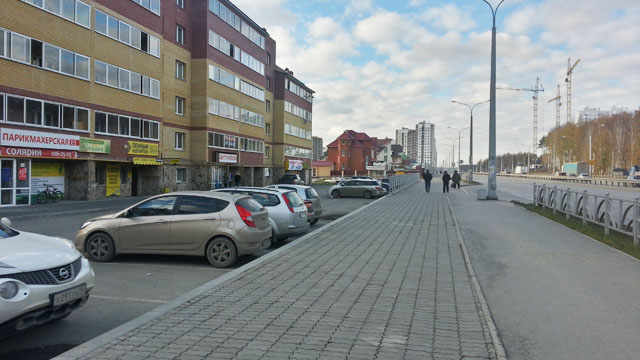
Krasnolesja street
It is not the only way to plan new developments. On the same Krasnolesja street, but in Academichesky neighborhood, despite the highway-like street infrastructure, buildings that face the sidewalk with commercial uses on the ground-floor create a totally different feeling of the public space.
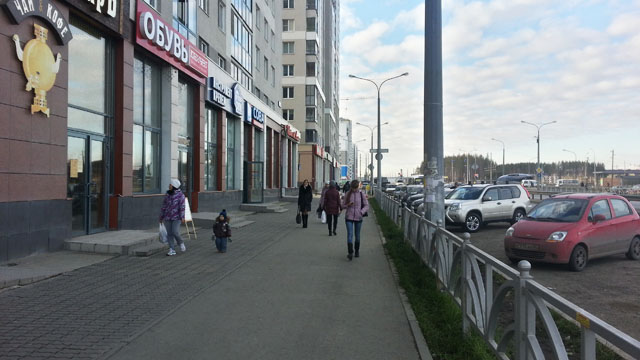
Krasnolesja street in Academichesky neighborhood
It seems though that even in Academichesky the solution was not conscious one, but rather a result of inertia of following the master plan that was initially designed by French architects. In later blocks the developer started sliding into the business-as-usual mode. For example on Shamanova street the architects haven’t thought of anything better but to face the sidewalk with a parking lot, guardrails and some kind of ventilation shaft.
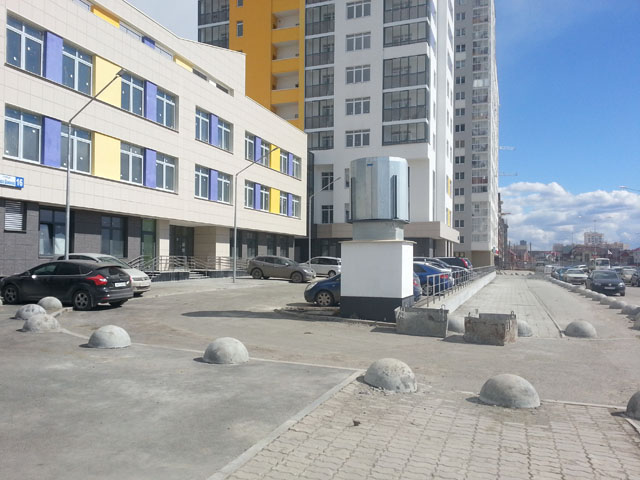
New development on Shamanova street
The dysfunction of buldings and their inability to create viable public spaces is best observed in bad weather. Good weather makes almost any street walkable enough but when it’s dark, grey and slushy, the quality of public space starts playing the leading role.
For example, standing on a sidewalk of Furmanova street one might ask him of herself: “What the hell am I doing here?”
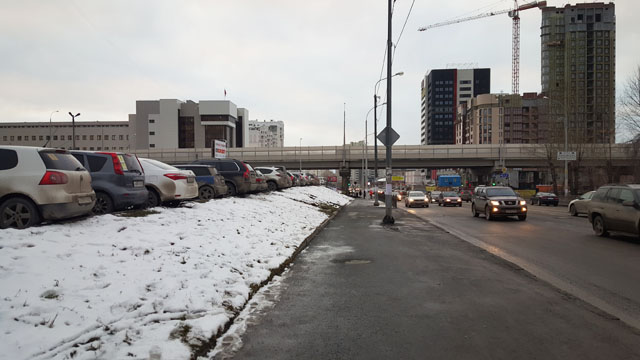
Furmanova street
At the same time on the parallel Bolshakova street (which is not frankly speaking a masterpiece) a person walking on the sidewalk is much closer to civilization and other people and in general feels him or herself much more comfortable.
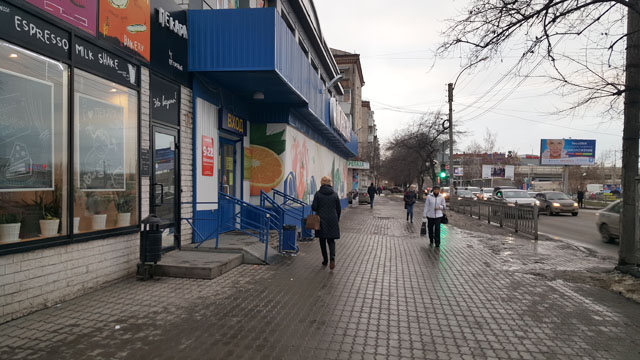
Bolshakova street
The meanest destructors of pedestrian-friendly spaces are of course shopping centers. It is considered important to create good car access and plenty of parking when building a shopping center. Why does it mean creating a hell for all those who didn’t drive though?
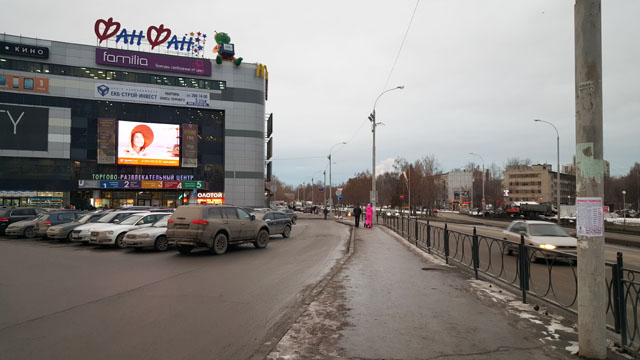
Posadskaya street near ‘Fan-fan’ shopping center”
Although the building is placed on the build-to line, almost all the area between it and the street is occupied by a supermarket unloading bay and a parking lot. All those are important for the shopping center to work, but they shouldn’t be implemented at the expense of the public space of the street.
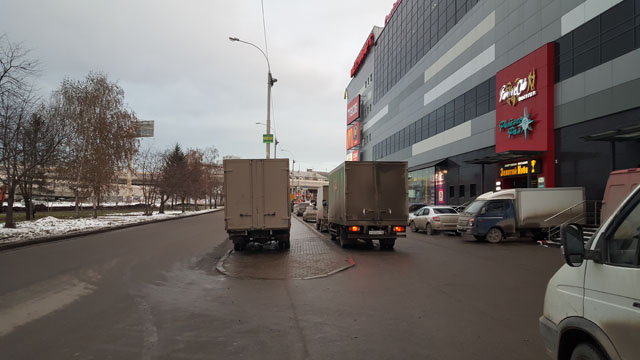
Posadskaya street near ‘Fan-fan’ shopping center”
Blank walls and fences are also public space killers. This is what pedestrians see when walking on the VIZ-boulevard for example:
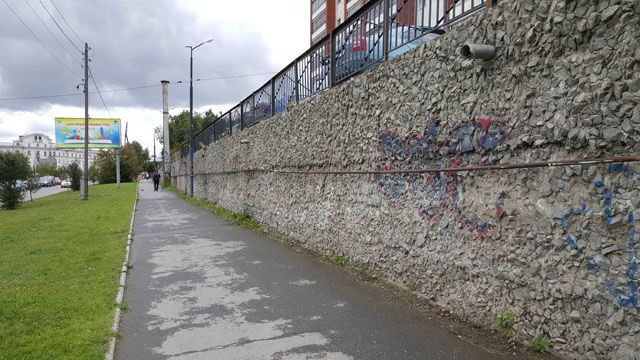
VIZ-boulevard. Residential block facade
Interestingly this apartment block sits next to a mansion that was build a hundred years prior but which creates a much friendlier urban frontage. Technologies and materials evolved but the ability of architects to create a good urban frontage degraded.
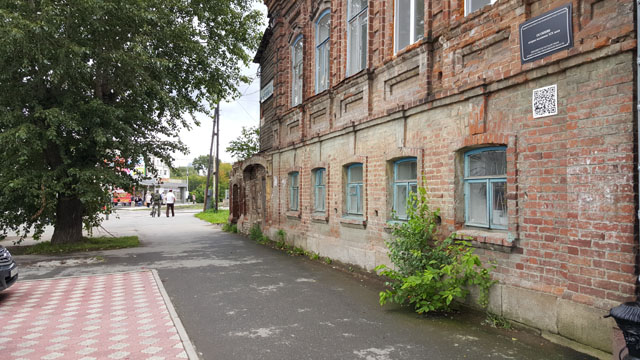
VIZ-Boulevard. 19th century mansion
Blank walls sometimes appear in the most unlikely places – like on this pedestrianized street in the center of Yekaterinburg.
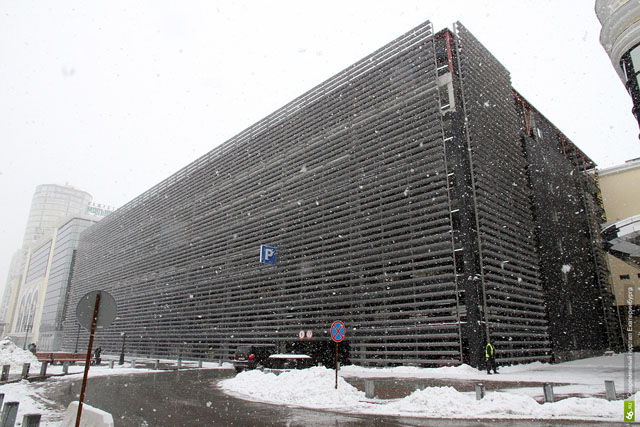
Parking garage of ‘Grinvich’ shopping mall on Vaynera street. Photo: 66.ru
Sometimes blank walls are combined with parking lots. Double blow for the public space of the street.
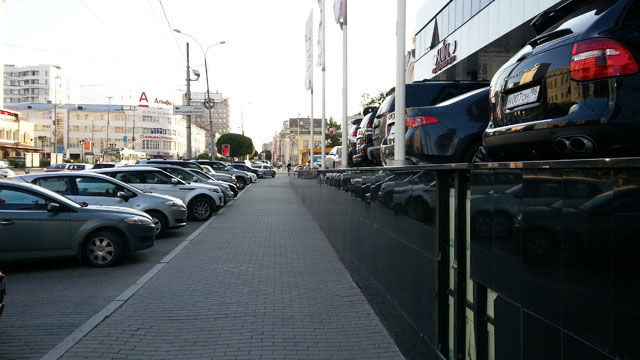
Sidwalk on Malysheva street near ‘Limerance’ center”
It’s worth mentioning that not all the new development is hostile to public spaces. There are some good examples.

Shopping gallery on Radisheva street
But it is obvious from reality that there’s no systemic approach to urban frontage and the end result depends on a variety of factors including the tastes of the architect and the developer. All that makes the appearance of good urban frontages rare and incidental.
What to do?
Obstacles that stand in the way of creating good urban streets are various and complex. There’s some progress in building better horizontal infrastructure of streets. The topic of space alocation for different street users is widely publicized and there’s a live interest to it both from the society and from the local governments.
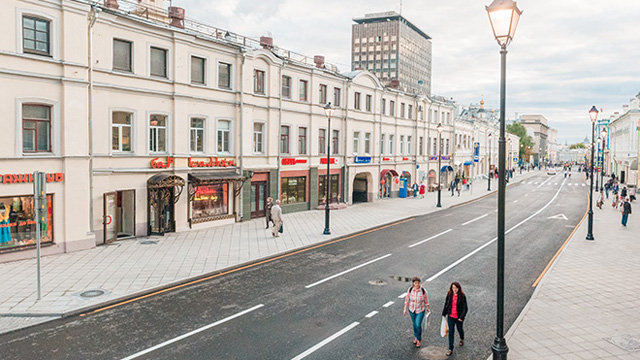
Refurbished Marosejka street in Moscow
Many of the problems that occur in the design of horizontal infrastructure of streets are rooted in the car-oriented national standards. Changing them is hard and tedious but some work is being done in that direction.
Some cities are also trying to create their own requirements for street design by creating municipal design manuals or guidelines. Such documents exist in Moscow and Saint-Petersburg. In Yekaterinburg one is being developed too.
What about the buildings?
Setting up building regulations that would guide development towards creating livable public spaces is both easy and hard at the same time.
It is hard because this issue in not yet reflected in the minds of architects and planners. For example the official town-planning council in Yekaterinburg discusses all sorts of things about new buildings but not the question of what public space these buildings would create. And this council only discusses projects located in the center of the city where street simply must be pedestrian-frindly.
Development on the outskirts completely goes downhill in regards to public space. There is no requirement to build urban streets in building regulations at the moment. As a result, clusters of highrise apartment blocks are being built without any streets at all, surrounded by garages and surface parking.
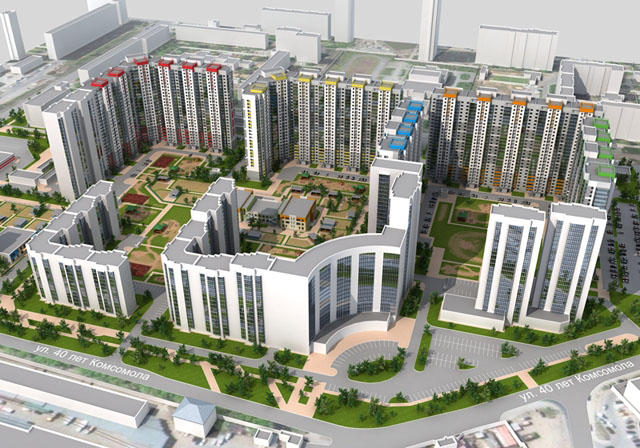
Residential complex ‘Rassvetnij’ in ZhBI neighborhood. No streets at all for residents of these 25-storey walls
Moreover, whole new neighborhoods are being planned in the worst traditions of modernism: with freestanding buildings, parking lots and roads between them.
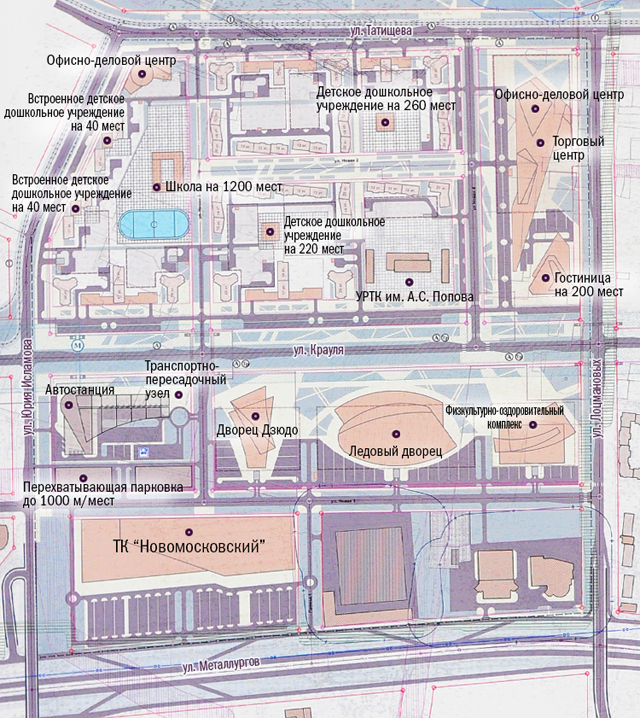
Master plan for a new neighborhood on the west border of the city. There isn’t a single street in this huge area that would be worth walking.
This is a deeply-rooted approach to development. Legions of architects, planners and administrators are trained to build only in that way. Changing the status-quo won’t be easy.
On the other hand, to start building differently it is not necessary to change the national stanards or any federal laws. What is needed to start building traditional urban streets again is regulated and can be implemented on a local level. And that gives a reason for optimism.
Sign-up to Live Streets on your favorite social network to keep track of the updates!